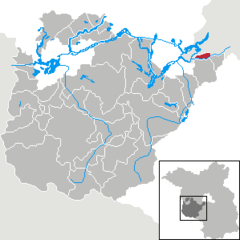
Potsdam-Mittelmark is a Kreis (district) in the western part of Brandenburg, Germany. Its neighbouring administrative units are the district of Havelland, the free cities of Brandenburg and Potsdam, the state of Berlin, the district of Teltow-Fläming, and the districts of Wittenberg, Anhalt-Bitterfeld and Jerichower Land in Saxony-Anhalt.

Teltow-Fläming is a Kreis (district) in the southwestern part of Brandenburg, Germany. Neighboring districts are Dahme-Spreewald, Elbe-Elster, the districts Wittenberg in Saxony-Anhalt, the district Potsdam-Mittelmark, and the Bundesland Berlin.

Steglitz-Zehlendorf is the sixth borough of Berlin, formed in Berlin's 2001 administrative reform by merging the former boroughs of Steglitz and Zehlendorf.

Kloster Lehnin, or just Lehnin, is a municipality in the German state of Brandenburg. It lies about 24 km (15 mi) west-south-west of Potsdam.

The Province of Brandenburg was a province of Prussia from 1815 to 1945. Brandenburg was established in 1815 from the Kingdom of Prussia's core territory, comprised the bulk of the historic Margraviate of Brandenburg and the Lower Lusatia region, and became part of the German Empire in 1871. From 1918, Brandenburg was a province of the Free State of Prussia until Prussia was dissolved in 1945 after World War II, and replaced with reduced territory as the State of Brandenburg in East Germany, which was later dissolved in 1952. Following the reunification of Germany in 1990, Brandenburg was re-established as a federal state of Germany, becoming one of the new states.

Teltow [German pronunciation:['tɛltoː] ] is a town in the Potsdam-Mittelmark district, in Brandenburg, Germany.
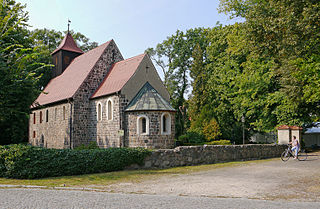
Stahnsdorf is a municipality in the Potsdam-Mittelmark district, in Brandenburg, Germany.

Berlin-Wannsee station is a railway station opened in 1874 which lies in the Wannsee district of Berlin, the capital city of Germany. It is an important traffic junction in south-west Berlin that is served by the RegionalExpress and RegionalBahn trains of the Deutsche Bahn, the Harz-Berlin-Express of Veolia Verkehr and by the Berlin S-Bahn. In summer, Wannsee serves as the Berlin terminal for DB AutoZug car carrying trains to and from southern Europe.

Schwielowsee is a municipality in the Potsdam-Mittelmark district, in Brandenburg, Germany. It is situated on the shore of the Schwielowsee lake, through which the River Havel flows. The municipality was founded on December 31, 2002 in merger of the three villages Caputh, Geltow and Ferch. The Caputh Ferry, a cable ferry across the Havel, links Caputh and Geltow. In the east Schwielowsee shares border with the City of Potsdam, in the west with the town of Werder (Havel).

Wusterwitz is a municipality in the Potsdam-Mittelmark district, in Brandenburg, Germany. Wusterwitz has a population of approximately 3,000 inhabitants.

Teltow Stadt (town) station is located about 500 metres (1,600 ft) east of the centre of Teltow in the German state Brandenburg to the south of Berlin on the Berlin-Lichterfelde Süd–Teltow Stadt railway. The line and the station were opened on 24 February 2005. It has two tracks next to an island platform and is located in a cutting. Mahlower Straße crosses over it on a bridge. Stairs and a lift connect the station to the street. Although the town of Teltow is in the Potsdam-Mittelmark district, the station is in the adjoining Teltow-Fläming district. The station should not be confused with Teltow railway station, which is 2 kilometres (1.2 mi) to the south-east on the Anhalt Railway itself, and is served by Regional-Express lines 3, 4 and 5.

Nikolassee is a locality (Ortsteil) of Berlin in the borough (Bezirk) of Steglitz-Zehlendorf, named after the small Nikolassee lake. Located in the affluent Southwest of the city, the area comprises parts of the Schlachtensee neighbourhood and the eastern shore of the Großer Wannsee lake with the large Strandbad Wannsee lido, as well as the islets of Schwanenwerder and Lindwerder.

The first section of the Berlin–Magdeburg Railway was opened in 1838 as the Berlin-Potsdam Railway and was the first railway line in Prussia. In 1846 it was extended to Magdeburg.
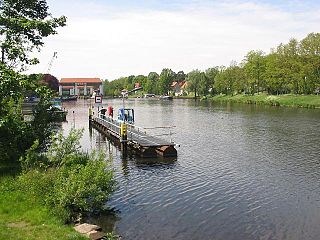
The Teltow Canal, also known as the in German, is a canal to the south of Berlin, the capital city of Germany. The canal lies in both the states of Berlin and Brandenburg, and at points forms the boundary between the two. It takes its name from the region of Teltow and town of Teltow which lie on its course. The canal was constructed between 1900 and 1906, when it was opened by Wilhelm II.
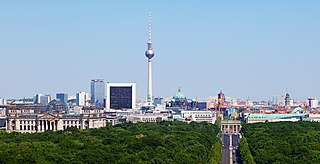
The Berlin/Brandenburg metropolitan region or capital region is one of eleven metropolitan regions of Germany, consisting of the entire territories of the state of Berlin and the surrounding state of Brandenburg. The region covers an area of 30,545 square kilometres (11,793 sq mi) with a total population of about 6.2 million.

Teltow station is located in the town of Teltow on the Anhalt Railway south of Berlin and was opened in 1901. Since then, the station has been repeatedly remodelled. The station served regional passenger and freight traffic and was the terminus of a Berlin S-Bahn service from 1950 to 1961. The direct connection to Berlin was lost with the construction of the Berlin Wall in 1961. It was restored in 2006.
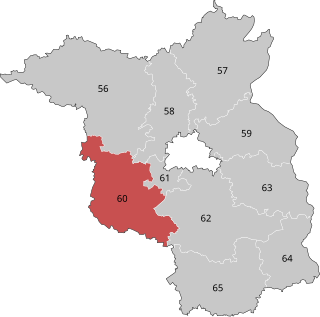
Brandenburg an der Havel – Potsdam-Mittelmark I – Havelland III – Teltow-Fläming I is an electoral constituency represented in the Bundestag. It elects one member via first-past-the-post voting. Under the current constituency numbering system, it is designated as constituency 60. It is located in western Brandenburg, comprising the city of Brandenburg an der Havel, most of the Potsdam-Mittelmark district, and parts of the Havelland and Teltow-Fläming districts.

Teltow is both a geological plateau and also a historical region in the German states of Brandenburg and Berlin. As an historical region, the Teltow was one of the eight territories out of which the March of Brandenburg was formed in the 12th and 13th centuries. As a result of the Teltow War (1239–1245) the question of territorial lordship of the newly created heart of the expanding march was finally decided here. Between 1835 and 1952 there was also a county, Teltow district; in addition a town immediately south of Berlin, in the present-day county of Potsdam-Mittelmark, bears the name Teltow.

Potsdam – Potsdam-Mittelmark II – Teltow-Fläming II is an electoral constituency represented in the Bundestag. It elects one member via first-past-the-post voting. Under the current constituency numbering system, it is designated as constituency 61. It is located in western Brandenburg, comprising the city of Potsdam and small parts of the Potsdam-Mittelmark and Teltow-Fläming districts.

The Parforceheide between the south of Berlin and the east of Potsdam is one of the last large contiguous forest areas in the Berlin-Brandenburg metropolitan region. Although located in Brandenburg, part of the forest is owned by the state of Berlin. The basis for this was created by the permanent forest contract or century contract of 1915. An area covering around 2350 hectares has been designated as the Parforceheide landscape conservation area since 1997. One of the aims of the conservation order is to preserve "the area's function as a climatic compensation area in the south of the Berlin conurbation". The name goes back to the par force hunts for which King Frederick William I of Prussia had the Stern hunting lodge built in the forest in 1730.
